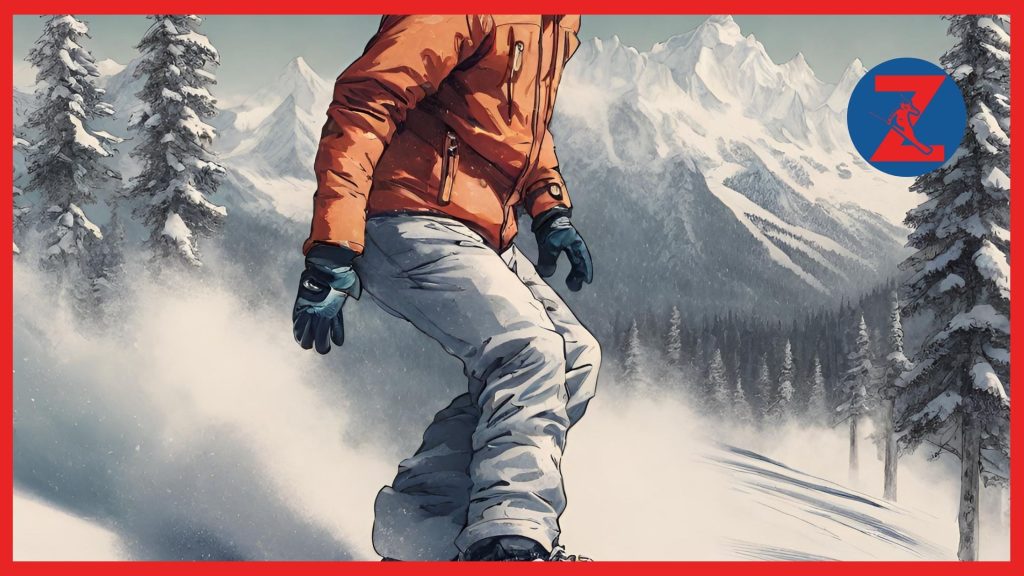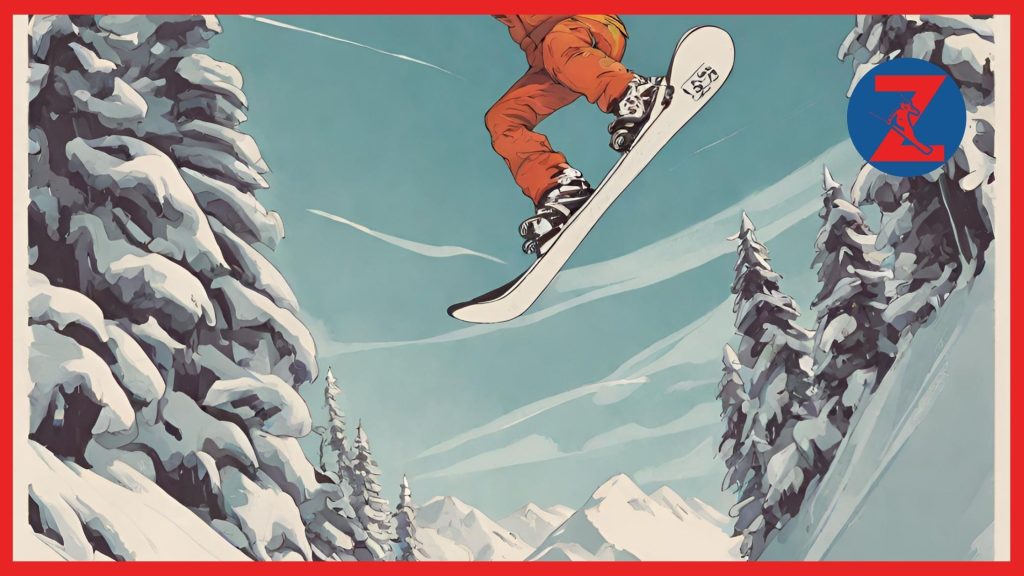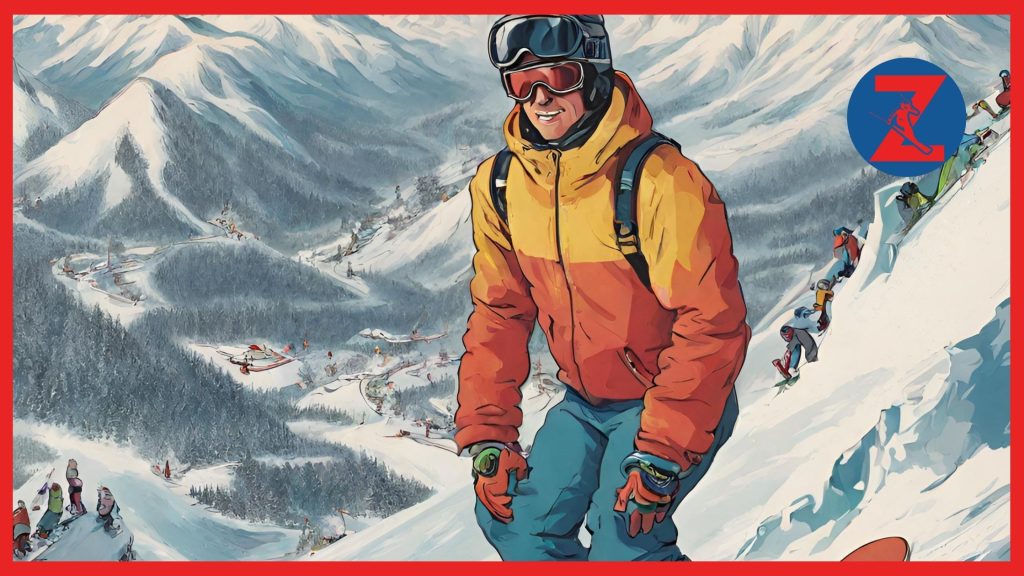Have you ever wondered how snowboarding went from a backyard pastime to a global phenomenon? How did this exhilarating winter sport develop and evolve over the years? Come with us on a journey as we delve into the roots, pioneers, and technological advancements that shaped the history of snowboarding.
The Early Days: Origins and Development

In the realm of snowboarding history, understanding its origins and development is crucial. This section takes a closer look at how snowboarding emerged and evolved, driven by influences from skateboarding, surfing, and skiing. Let’s journey back in time and explore the key milestones in the timeline of snowboarding.
It all began in the 1960s when pioneers like Sherman Poppen and Tom Sims paved the way for this exhilarating sport. Inspired by their love for surfing and skateboarding, they set out to create a way to experience those thrilling sensations on the snow-covered mountains.
“Snowboarding is about capturing the magic. It’s like nothing else in the world.” – Jake Burton
The early snowboards were rudimentary, often consisting of wooden planks with ski bindings attached. However, as the sport gained momentum, advancements were made to improve the equipment’s functionality and performance. This led to the development of more specialized snowboards, bindings, and boots designed exclusively for snowboarding.
As snowboarding gained popularity, it began to attract attention from ski resorts and winter sports enthusiasts. Ski resorts initially resisted the influx of snowboarders, considering it a reckless and dangerous activity. However, the persistence of snowboarding enthusiasts and the growing demand eventually led to the acceptance and integration of snowboarding into mainstream winter sports.
Throughout the 1970s and 1980s, snowboarding continued to evolve and refine its techniques. Freestyle snowboarding gained traction, leading to the rise of halfpipe and big air competitions. Snowboarding became an art form, as riders started experimenting with new tricks, styles, and maneuvers.
By the 1990s, snowboarding had firmly established itself within the sports industry. The Winter Olympics recognized snowboarding as a competitive discipline, showcasing the sport’s rapid growth and widening appeal.
Today, snowboarding has become a global phenomenon, capturing the hearts of individuals all over the world. From its humble beginnings to its current status as a staple winter sport, snowboarding’s vibrant history and undeniable influence continue to shape the culture of mountain sports.
Pioneers and Influencers in Snowboarding History
Throughout the evolution of snowboarding, numerous pioneers and influencers have left their mark on the sport. These individuals not only contributed to its growth and innovation but also played a crucial role in elevating the recognition and popularity of snowboarding.
One of the earliest snowboarding pioneers was Sherman Poppen, who invented the Snurfer in the late 1960s. Poppen’s creation, a precursor to the modern snowboard, allowed riders to slide down snowy slopes with ease and sparked interest in the sport.
Another influential figure in snowboarding history is Jake Burton Carpenter, who founded Burton Snowboards in the 1970s. Carpenter’s dedication to perfecting snowboard designs and promoting the sport helped establish snowboarding as a legitimate discipline.
“Snowboarding is an art, a lifestyle, a culture, a sport, a business, and a journey.”- Jake Burton Carpenter
Rider Craig Kelly, often referred to as the “godfather of freestyle snowboarding,” revolutionized the sport with his innovative riding style and tricks. Kelly’s combination of technical skill and creative expression paved the way for future snowboarding athletes.
In recent years, riders like Shaun White and Chloe Kim have propelled snowboarding to new heights with their achievements in competitive snowboarding. Their legendary performances in events like the Winter Olympics have captivated audiences worldwide, inspiring a new generation of snowboarders.
It’s important to acknowledge the contributions of these pioneers and influencers in snowboarding. Their dedication, passion, and commitment to pushing the boundaries of the sport have shaped the snowboarding landscape we know today.
| Name | Contribution |
|---|---|
| Sherman Poppen | Invented the Snurfer, a precursor to the modern snowboard |
| Jake Burton Carpenter | Founded Burton Snowboards and revolutionized snowboard design |
| Craig Kelly | Developed the freestyle snowboarding movement |
| Shaun White | Legendary snowboarder with multiple Olympic gold medals |
| Chloe Kim | Olympic gold medalist and trailblazer for women in snowboarding |
From Underground to Mainstream: Snowboarding’s Rise in Popularity

Snowboarding, once considered an underground activity, has now emerged as a mainstream phenomenon. Over the years, the sport has experienced a remarkable evolution, capturing the attention and hearts of adventure enthusiasts worldwide. This section explores the factors that contributed to snowboarding’s rise in popularity, shedding light on the cultural shifts, media exposure, and competitive events that played a pivotal role in its journey.
The Role of Cultural Shifts
As snowboarding began to gain traction in the 1970s, it appealed to a counterculture audience seeking an alternative to traditional skiing. The sport’s rebellious and independent spirit resonated with a younger generation, which propelled snowboarding into the mainstream. By the 1990s, snowboarding had become a symbol of freedom, self-expression, and pushing boundaries.
“Snowboarding represents freedom. It’s about breaking down barriers and challenging the status quo.” – Jake Burton, founder of Burton Snowboards
The acceptance and integration of snowboarding into popular culture can be attributed to its representation in films, music, and fashion. Snowboarding icons like Shaun White and Chloe Kim became household names, inspiring a new wave of enthusiasts to take up the sport. Snowboarding rapidly evolved from a niche subculture to a mainstream activity, capturing the imagination of individuals across age groups and backgrounds.
The Power of Media Exposure
The rise of snowboarding’s popularity was greatly fueled by the media’s increased coverage of the sport. Television networks, magazines, and digital platforms played a crucial role in showcasing the exhilarating and adrenaline-fueled nature of snowboarding. Broadcasts of high-profile competitions, such as the Winter X Games and the Winter Olympics, brought snowboarding to millions of viewers worldwide, allowing them to witness the sport’s spectacle and its remarkable athletes in action.
Additionally, the advent of social media and online video platforms provided a platform for snowboarders to showcase their skills and creativity. Through viral videos and digital content, riders like Travis Rice and Mark McMorris gained massive followings, further solidifying the sport’s mainstream appeal.
Competitive Events: Elevating the Sport
The rise of competitive snowboarding events also played a crucial role in elevating the sport’s popularity. These events not only showcased the skills of top snowboarding athletes but also exposed the sport to wider audiences. The establishment of professional snowboarding competitions, such as the U.S. Open Snowboarding Championships and the World Snowboarding Championships, provided a platform for athletes to compete against each other and push the boundaries of what was considered possible.
| Event | Year Established | Notable Winners |
|---|---|---|
| X Games | 1997 | Shaun White, Chloe Kim |
| Olympic Snowboarding | 1998 (official) | Shaun White, Chloe Kim |
| U.S. Open Snowboarding Championships | 1982 | Kelly Clark, Mark McMorris |
These competitive events not only served as a platform for athletes to showcase their skills but also introduced innovative tricks, jumps, and styles that pushed the boundaries of the sport and captivated audiences worldwide.
In summary, snowboarding’s remarkable rise in popularity can be attributed to a combination of cultural shifts, media exposure, and competitive events. As the sport continues to evolve, it remains an exhilarating and influential force in the world of winter sports.
Technological Advancements in Snowboarding

Over the years, snowboarding has witnessed remarkable snowboarding development and evolution of snowboarding. One significant aspect that has contributed to the sport’s growth and enhanced the rider’s experience is the continuous technological advancements in snowboarding equipment and gear. The evolution in snowboards, bindings, boots, and other essential gear has revolutionized the way enthusiasts enjoy this exhilarating winter activity.
The Evolution of Snowboards
One of the most notable advancements in snowboarding is the progressive design and construction of snowboards. From traditional flat boards to the introduction of camber and rocker profiles, the development in board shapes and contours has significantly improved performance and maneuverability on various snow conditions.
The evolution of materials used in snowboard construction is another key factor. With the utilization of lightweight yet durable materials such as carbon fiber, fiberglass, and high-density wood cores, manufacturers have been able to create snowboards that offer enhanced flex, response, and stability.
Moreover, the incorporation of advanced edge technology, including serrated or wavy edges, has improved edge hold and grip on icy slopes. This innovation has provided riders with increased control and confidence, especially in challenging terrain.
Bindings and Boots
The evolution of snowboarding bindings and boots has also greatly contributed to the sport’s development. Modern bindings feature improved ergonomic designs, allowing for better power transmission and control. The use of high-quality materials and adjustable components ensures a customized fit that enhances comfort and performance.
Furthermore, advancements in boot technology have revolutionized the sport by prioritizing comfort, support, and warmth. Key features such as customizable liners, heat-moldable shells, and innovative lacing systems have significantly improved the overall snowboarding experience.
The Future of Snowboarding Technology
As technology continues to advance, we can anticipate further snowboarding development and evolution in the coming years. Industry experts are continually exploring new materials, designs, and construction techniques to push the boundaries of performance and safety in snowboarding gear.
Imagine snowboards with integrated sensors that provide real-time data on speed, balance, and technique, allowing riders to track their progress and make necessary adjustments to enhance their performance. Additionally, advancements in wearable technology and smart fabrics could lead to more efficient insulation and temperature regulation, ensuring optimal comfort even in extreme weather conditions.
In conclusion, the technological advancements in snowboarding equipment and gear have played a pivotal role in the sport’s development and evolution. These innovations have not only enhanced the performance and comfort of riders but have also opened new doors for creativity and progression in snowboarding.
| Advancements | Benefits |
|---|---|
| Progressive snowboard design and construction | Improved performance and maneuverability |
| Utilization of lightweight yet durable materials | Enhanced flex, response, and stability |
| Advanced edge technology | Increased control and confidence on icy slopes |
| Ergonomic bindings with better power transmission | Improved control and comfort |
| Innovative boot features | Customizable fit, support, and warmth |
| Potential future advancements | Real-time data tracking, smart fabrics, and more |
Conclusion
In conclusion, the history of snowboarding is a fascinating journey that showcases the sport’s remarkable evolution. From its humble origins as a backyard pastime to its global popularity today, snowboarding has come a long way.
Throughout this article, we explored the timeline of snowboarding’s development, highlighted the pioneers and influencers who shaped the sport, and discussed the technological advancements that have propelled its growth.
Looking ahead, the future of snowboarding is bright. As the sport continues to gain momentum and attract new enthusiasts, we can anticipate further innovations in equipment, styles, and competitions. Snowboarding’s evolution remains ongoing, ensuring its enduring relevance and appeal to both athletes and spectators alike.
FAQ
Q: What is the history of snowboarding?
A: Snowboarding has its origins in the 1960s when Sherman Poppen created a toy called the “Snurfer,” which was essentially a surfboard for the snow. It gained popularity as a backyard activity, and in the 1970s, snowboarding began to evolve with the introduction of bindings and the first snowboard-specific competitions.
Q: Who are some of the pioneers and influencers in snowboarding history?
A: Some notable pioneers and influencers in snowboarding history include Jake Burton Carpenter, who started Burton Snowboards and played a significant role in popularizing the sport, and Tom Sims, who invented the first metal-edged snowboard. Other influential figures include Craig Kelly, Terje Haakonsen, and Shaun White.
Q: How did snowboarding transition from being an underground activity to a mainstream phenomenon?
A: Snowboarding’s rise in popularity can be attributed to various factors. In the 1980s and 1990s, the sport gained exposure through movies, magazines, and televised events. As more people took up snowboarding, ski resorts began to recognize its potential and allowed snowboarders on their slopes. This increased accessibility and acceptance led to the sport’s mainstream success.
Q: How has snowboarding equipment and gear evolved over time?
A: Snowboarding equipment has undergone significant advancements over the years. Snowboards have become lighter, more responsive, and more durable. Bindings and boots have also improved, offering better control and comfort. Technological innovations like reverse camber and rocker profiles have revolutionized snowboard designs, enhancing performance and maneuverability.
Q: What does the future hold for snowboarding?
A: Snowboarding continues to evolve and adapt to new trends and preferences. It is likely that technological advancements will further enhance equipment and gear, making snowboarding more accessible and enjoyable for all. Additionally, the sport may continue to expand internationally, reaching new markets and demographics.






